Hey there, adventure seekers! If there’s one thing that keeps drawing me back to the trails and shores of North Carolina, it’s the sheer serenity you find in the state’s national parks. As a traveler who’s spent more weekends than I can count chasing that peaceful escape – my old hiking boots caked in red clay from the mountains and sand from the coast – I’ve come to see these spots as my personal reset buttons. Picture this: a few years back, I was feeling burnt out from city life in Charlotte, so I grabbed my backpack on a whim and headed to one of the NC national parks for a quick day hike. By sunset, surrounded by whispering pines and the distant roar of a waterfall, all that stress just melted away. That’s the magic of a national park nc – it’s not just about the views; it’s about finding that inner calm amid nature’s chaos. Running carolinatravelpop.com has let me share these hidden havens with fellow wanderers, and if you’re hunting for a national park in north carolina or curious about the north carolina national park scene, stick with me. We’ll dive into the national parks in north carolina, from the misty peaks to the salty seashores, all with stories straight from my own rambles. Trust me, whether you’re pondering national parks in nc, a national park north carolina getaway, or just national parks north carolina in general, these places deliver serenity for the win every time.
I’ve trekked through most of them over the years – from family outings to solo soul-searching – and each visit reminds me why North Carolina punches above its weight in natural wonders. If you’re asking, “What national parks are in north carolina?” or “How many national parks are in north carolina?” (spoiler: there are about a dozen key sites managed by the National Park Service, though not all are traditional parks like Yellowstone), I’ve got the scoop. We’ll cover the list of national parks in north carolina, throw in a north carolina national parks map vibe, and even touch on national monuments north carolina for good measure. For folks near the cities, like national parks in charlotte nc or national parks near raleigh nc, there are options closer than you think. And hey, if you’re into obx national park adventures or national parks nc map planning, we’ll get there too. These aren’t just postcard spots; they’re where I’ve found real peace, like that time I watched the sun rise over a foggy valley and felt like the world stood still.
When to Chase Serenity in North Carolina’s National Parks
Timing your visit to a national park in nc can make or break the experience – too hot, and you’re sweating through your shirt; too crowded, and that serenity vanishes. From my countless trips, spring (April-May) and fall (September-November) are prime for nc national park explorations. The weather’s mild, wildflowers bloom in spring, and fall foliage turns everything into a fiery masterpiece – perfect for those asking about the best national parks in north carolina. Last October, I hit a national parks near asheville trail, and the colors were so vibrant, it felt like stepping into a painting. Summer’s great for coastal national parks near nc, like those with national parks camping outer banks nc options, but pack bug spray and go early to beat the heat; I’ve learned after a sweltering day at a national parks near asheville north carolina site.
Winter has its own quiet charm for federal parks in nc or nps nc visits – fewer people mean more solitude, and snow-dusted paths add a fairy-tale vibe, though check for closures. For “is there a national park in north carolina” skeptics, yes, and winter hikes prove it. Avoid peak holidays if crowds bug you; mid-week is my secret for how many national parks in nc serenity. Apps like AllTrails or the NPS site are gold for updates, especially for national parks near charlotte or national parks near raleigh. And if you’re mapping out national parks in north carolina map or north carolina national parks map routes, factor in weather – a rainy day once turned my plan into a cozy visitor center tour. For the best parks in north carolina or national parks near north carolina, these seasons maximize that win-worthy peace.
NC’s Top National Park Sites: Where Serenity Meets Adventure
Over years of exploring, I’ve narrowed down the must-sees in the national parks north carolina lineup – not just the big names, but the ones that left me recharged. These are the national parks in nc with campgrounds, trails, and views that scream serenity. We’ll go through the national parks in north carolina list, sharing my personal highs (and the occasional low, like forgetting bug spray). If you’re wondering “are there any national parks in north carolina” or “how many national parks in north carolina,” count on about 12 key NPS sites, from mountains to shores. Here’s my take on the best national parks in north carolina, with tips for national parks near asheville nc or even charlotte nc national park day trips.
NC National Parks at a Glance
| Park / Site | Region | Highlight | Best Season | Traveler Tip |
|---|---|---|---|---|
| Great Smoky Mountains NP | Western NC | Foggy peaks, waterfalls, wildlife | Spring & Fall | Free entry; arrive early for Clingmans Dome parking |
| Blue Ridge Parkway | Mountains | Scenic drives, overlooks | Fall for foliage | Free; stop at Linville Falls for short hikes |
| Cape Hatteras Seashore | OBX Coast | 70 miles of beach, lighthouse | Summer | Campgrounds ~$25; book Ocracoke ferry early |
| Cape Lookout Seashore | OBX Coast | Wild horses, ferry islands | Spring & Fall | Bring all supplies — no services on islands |
| Wright Brothers Memorial | OBX Coast | First flight site | Year-round | $10 entry; go early in summer to avoid crowds |
| Appalachian Trail (NC) | Mountains | 88 miles of AT, Roan Highlands | Spring & Fall | Free; trailheads fill fast on weekends |
| Carl Sandburg Home | Flat Rock | Farm, poetry, goats | Spring | Free grounds; $10 for house tour |
| Fort Raleigh Site | OBX | Lost Colony drama | Summer | Free; parking tight on show nights |
| Guilford Courthouse | Greensboro | Revolutionary battlefields | Spring | Free; visitor center lot small |
| Moores Creek Battlefield | Near Wilmington | Boardwalk over swampy battlefield | Spring | Free; trails may flood after rains |
| Overmountain Victory Trail | Foothills/Mountains | Revolutionary route trail sections | Fall | Free; check NPS maps for access points |
| Trail of Tears Trail | Smokies / Cherokee | Historic removal route | Year-round | Free; best with museum visit in Cherokee |
1. Great Smoky Mountains National Park: Misty Magic in the Mountains
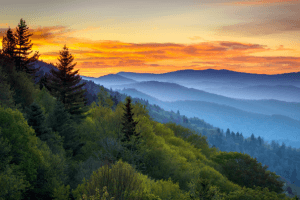
Topping my list for a national park north carolina escape is Great Smoky Mountains – technically shared with Tennessee, but NC’s side is pure bliss. I’ve hiked here dozens of times, from dawn patrols to full-moon treks, and the fog-shrouded peaks always deliver that deep serenity. Last spring, I tackled a trail near Clingmans Dome, the highest point in the park, and stood there as clouds parted like a curtain – talk about a win! It’s one of the most visited national parks near nc, but early mornings keep it peaceful. For “what national parks are in north carolina” fans, this is the crown jewel, with over 800 miles of trails for every level. I once camped at a national parks in nc with campgrounds site here, waking to deer grazing nearby – pure magic.
If you’re near Asheville, it’s a short drive for— and pairing it with one of Asheville’s best hikes makes for a perfect weekend. Pack layers; weather flips fast. For national parks nc map planning, grab one at the visitor center – helped me find hidden waterfalls. And if you’re asking “how many national parks in nc” include this, it’s the only traditional one, but worth every mile.
- Fees: Free entry (one of the few major national parks with no entrance fee).
- Best trailheads: Clingmans Dome, Alum Cave, Deep Creek (for waterfalls).
- Parking tip: Clingmans Dome fills by 9 a.m. on weekends — go at sunrise or midweek.
2. Blue Ridge Parkway: The Scenic Drive of Dreams
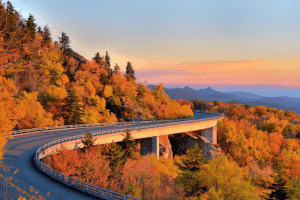
Ah, the Blue Ridge Parkway – not a traditional park, but a national parks north carolina staple stretching 469 miles. I’ve driven sections countless times, windows down, feeling the wind whip through as views unfold like a storybook. One memorable trip, I started from Asheville (national parks near asheville nc vibes) and pulled over at every overlook, picnicking with mountain panoramas. It’s perfect for those seeking national parks in north carolina map routes that double as therapy. Serenity here is in the journey – no rush, just curves and colors.
For national parks near charlotte nc, hop on near Asheville; the drive’s doable in a day. I’ve spotted black bears from pull-offs – heart-pounding but peaceful. If you’re compiling a list of national parks in north carolina, this 1930s-era road is essential, with hikes like Linville Falls adding adventure.
- Fees: Free to drive.
- Best stops/trailheads: Linville Falls, Craggy Gardens, Rough Ridge.
- Parking tip: Overlooks fill quickly in October (fall foliage). Arrive early for leaf-peeping.
3. Cape Hatteras National Seashore: Coastal Calm on the OBX
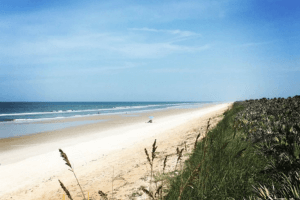
Shifting to the coast, Cape Hatteras is my go-to for obx national park serenity – 70 miles of barrier islands with crashing waves and endless dunes. I’ve beachcombed here after storms, finding shells like treasures, and climbed the iconic lighthouse for 360-degree views that wash away worries. One summer, I camped at a national parks camping outer banks nc site, falling asleep to ocean lullabies – ultimate win.
For national parks near raleigh nc or national park near raleigh nc, it’s a scenic drive east. Birdwatching and fishing add layers; I once reeled in a drum fish at dawn. On your national parks in north carolina list, this seashore shines for water lovers— especially if you’re booking an Outer Banks vacation rental.
- Fees: Free entry; campgrounds charge ~$20–30 per night.
- Best campgrounds: Frisco, Ocracoke, Cape Point.
- Parking tip: Limited near Ocracoke Lighthouse; take ferry and walk in.
4. Cape Lookout National Seashore: Untamed Island Escape

Sister to Hatteras, Cape Lookout feels wilder – ferry rides to uninhabited islands for shelling and wild horses. I’ve kayaked here, paddling through marshes with only birds for company, finding that rare solitude. A highlight: climbing the diamond-patterned lighthouse for panoramic serenity.
Accessible from the coast, it’s great for national parks near north carolina beach days. Pack everything; no facilities mean pure nature. For how many national parks in nc coastal vibes, this is a must.
- Fees: Ferry ticket ($18–20 round trip).
- Best camping: Primitive — bring everything. Shackleford Banks popular for wild horse viewing.
- Parking tip: Park at ferry docks on mainland (Beaufort or Harkers Island).
5. Wright Brothers National Memorial: Where Dreams Take Flight

In Kill Devil Hills, this site commemorates the first flight – I’ve stood on those dunes, wind in my hair, imagining the brothers’ triumph. The museum’s interactive, but the real serenity is walking the flight path, feeling history’s whisper.
Near OBX, it’s a solid add to any trip — just check the Outer Banks annual weather before you go. For national monuments north carolina, it’s inspirational.
- Fees: $10 per person, free for kids under 15.
- Parking tip: Ample parking at the visitor center, but summer weekends get crowded.
6. Appalachian National Scenic Trail: The Epic Hike Through NC
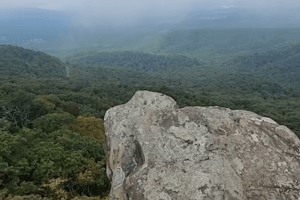
The AT slices 88 miles through NC – I’ve section-hiked parts, from Georgia to Virginia borders, finding peace in the rhythm of steps. One foggy morning near Roan Mountain, wildflowers bloomed like confetti – serenity overload.
For national parks near asheville, access points abound. It’s on every list of national parks in north carolina for thru-hikers or day trippers.
- Fees: Free.
- Best NC sections: Roan Highlands, Max Patch, Nantahala Gorge.
- Parking tip: Trailheads like Carver’s Gap are popular — get there before 8 a.m.
7. Carl Sandburg Home National Historic Site: Poetic Peace in the Hills

In Flat Rock, this farm-home of the poet offers trails and goat barns – I’ve wandered the grounds, reading verses amid gardens, feeling creatively recharged.
Near Asheville, it’s a chill spot — and I’ve capped my day there with fine dining in Asheville more than once.
- Fees: Free for grounds and trails; small fee (~$10) for house tour.
- Parking tip: Lot fills fast on weekends; overflow across the street.
8. Fort Raleigh National Historic Site: Lost Colony Mysteries

On Roanoke Island, explore the first English settlement – I’ve attended the outdoor drama, pondering the vanished colonists under starry skies. One summer night I stayed for the outdoor drama, and I’ll never forget how the ocean breeze carried the actors’ voices — it felt like history was alive right in front of me.
Coastal, ties into obx national park history.
- Fees: Free.
- Best time: Evening outdoor drama (“The Lost Colony” show).
- Parking tip: Easy access, but plan ahead during show nights.
9. Guilford Courthouse National Military Park: Revolutionary Roots

In Greensboro, battlefields and monuments – I’ve biked the trails, reflecting on history’s turning points in quiet woods. I once rode my bike here at sunrise, and the mist rising from the battlefield made it feel almost sacred, like stepping back in time.
For national parks near raleigh, it’s accessible.
- Fees: Free.
- Best for: Biking/walking battlefield loops.
- Parking tip: Visitor center lot is small; use overflow on busy weekends.
10. Moores Creek National Battlefield: Swampy Serenity

Near Wilmington, this Revolutionary site has boardwalks over creeks – I’ve hiked here, birdsong the only sound, finding unexpected peace. I paused on the boardwalk to watch a blue heron fishing in the creek — the kind of quiet moment you don’t expect at a battlefield.
- Fees: Free.
- Best trail: Boardwalk loop (easy, <1 mile).
- Parking tip: Plenty, but watch for flooding after heavy rains.
11. Overmountain Victory National Historic Trail: Mountain March
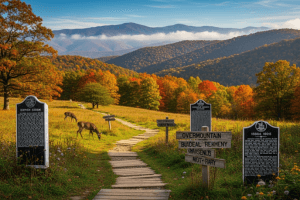
Tracing Revolutionary paths, I’ve followed sections, imagining soldiers’ trek – serene forests with historical weight. Hiking one section near South Mountains, I could almost hear the crunch of boots from centuries ago — it gave me chills in the best way.
- Fees: Free.
- Highlights: Sections near Lake James and South Mountains State Park.
- Parking tip: Trailheads are scattered; check NPS site for local access.
12. Trail of Tears National Historic Trail: Somber Reflection
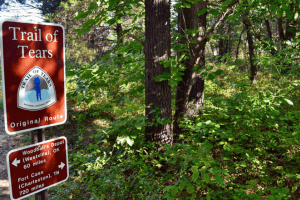
Commemorating Cherokee removal, sites offer poignant serenity – I’ve visited, learning and reflecting on resilience. Walking through Cherokee country, I stopped at a small roadside marker, and the silence there hit harder than any textbook ever could.
- Fees: Free.
- Best stops: Museum of the Cherokee Indian, NC sections in Smokies.
- Parking tip: Most sites are pull-offs with limited spaces.
These cover how many national parks are in north carolina (12 key sites), from national parks in charlotte nc drives to coastal gems.
Essential Tips for Exploring North Carolina’s National Parks
After mishaps like forgotten rain gear, here’s my advice for nc national park visits:
- Gear Up: Layers, sturdy shoes, bug spray – essentials for national park in nc hikes.
- Plan Smart: Use national parks nc map or apps; check permits for national parks in nc with campgrounds.
- Safety First: Stay on trails, especially in national parks near charlotte nc.
- Eco-Friendly: Leave no trace for future serenity.
- Local Flavor: Chat rangers; they’ve shared hidden spots.
For best national parks in north carolina or national parks near raleigh nc, these ensure a win.
Wrapping Up Your NC National Parks Journey
There you have it – my heartfelt guide to North Carolina national parks, where serenity always wins. From misty Smokies to coastal capes, these spots have been my sanctuaries. If you’re mountain-bound, crash at the best Boone hotels. If you’re chasing salt air, treat yourself to Myrtle Beach eats , offering peace amid life’s hustle. If this sparks your wanderlust, whether for national parks near asheville or obx national park, dive in. For more Carolina tips, visit carolinatravelpop.com. Safe trails – may your visits be as rejuvenating as mine!
FAQs About National Parks in North Carolina
What is the only official national park in North Carolina?
The Great Smoky Mountains is the crown jewel. I’ve hiked here more times than I can count, and standing on Clingmans Dome at sunrise with clouds rolling under your feet is something you don’t forget.
Which NC national park is best for families?
Carl Sandburg Home surprised me. Kids love the goat barns, and adults can stroll the easy trails. I once watched a family picnic on the lawn while goats wandered nearby — simple, fun, and stress-free.
Can you camp at Cape Hatteras or Cape Lookout?
Yes! I camped at Ocracoke once and fell asleep to ocean waves pounding the shore — pure magic. Just remember, Hatteras has organized campgrounds, while Cape Lookout is totally primitive. You bring everything.
What’s the best season for North Carolina national parks?
Fall, hands down. Last October, I hit the Blue Ridge Parkway, and the foliage looked like fire on the ridgelines. It’s busy, but if you go mid-week, you get that quiet magic all to yourself.
Are there fees to visit NC’s national parks?
Most sites are free, which blew my mind after paying at places out West. The Wright Brothers Memorial is one of the few that charges (about $10), but walking the first flight path at sunset was worth every penny.
Which park is the quietest or least crowded?
Cape Lookout wins here. I took a ferry over one spring, and for hours it was just me, the waves, and a few wild horses. No crowds, no noise — just raw Carolina coast.
What’s the best short hike for a first-time visitor?
Hebron Falls on the Boone Fork Trail. It’s not in a big “national park,” but part of the Blue Ridge Parkway system. I once stopped there with just a water bottle and a sandwich — two hours later, I was still sitting by the cascade, lost in the sound of rushing water.


Pingback: 5 of The Best North Carolina Lakes